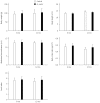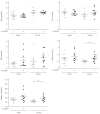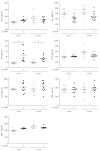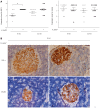Potential effect of chronic Helicobacter pylori infection on glucose metabolism of Mongolian gerbils
- PMID: 26640335
- PMCID: PMC4658613
- DOI: 10.3748/wjg.v21.i44.12593
Potential effect of chronic Helicobacter pylori infection on glucose metabolism of Mongolian gerbils
Abstract
Aim: To assess the effect of Helicobacter pylori (H. pylori) infection on metabolic parameters in Mongolian gerbils.
Methods: A total of 40 male, 5- to 8-wk-old, specific-pathogen-free Mongolian gerbils (30-50 g) were randomly allocated into two groups: a control group (n = 20) and an H. pylori group (n = 20). After a two-week acclimation period, the control group was administered Brucella broth and the H. pylori group was challenged intra-gastrically five times every other day with approximately 10(9)/CFU H. pylori ATCC43504 (CagA+, VacA+). Each group was then divided into two subgroups, which were sacrificed at either 6 or 12 mo. The control and H. pylori subgroups each contained 10 Mongolian gerbils. Body weight, abdominal circumference, and body length were measured, and body mass index (BMI) and Lee's index were calculated. Biochemical assays were used to detect serum indexes, including glucose, glycated hemoglobin (GHb), glycated hemoglobin A1c (HbA1c), triacylglycerol, and total cholesterol, using an automatic biochemistry analyzer. Inflammatory cytokines, including interleukin (IL)-1β, IL-2, IL-4, IL-10, IL-12, tumor necrosis factor-α (TNF-α) and interferon (IFN)-γ, were assayed using ELISA. The expression of insulin and insulin-like growth factor 1 (IGF-1) was detected by immunohistochemistry, and islet apoptosis was measured using the terminal deoxynucleotidyl transferase-mediated dUTP nick end labeling (TUNEL) assay.
Results: At each time point, body weight, abdominal circumference, BMI, and Lee's index were increased after H. pylori infection. However, these differences were not significant. H. pylori infection significantly increased the GHb (5.45 ± 0.53 vs 4.98 ± 0.22, P < 0.05) and HbA1c (4.91 ± 0.61 vs 4.61 ± 0.15, P < 0.05) levels at 12 mo. We observed no significant differences in serum biochemical indexes, including fasting blood glucose, triacylglycerol and total cholesterol, at 6 or 12 mo after infection. H. pylori infection significantly increased the expression of IGF-1 (P < 0.05). Insulin levels from the pancreas and the apoptotic rate of islet β-cells remained unchanged. Also, we observed no significant differences among cytokines levels, including IL-1β, IL-2, IL-4, IL-10, IL-12, TNF-α and IFN-γ. IL-4 was the only exception, which increased at 6 (44.36 ± 25.17 vs 17.38 ± 3.47, P < 0.05) and 12 mo (33.41 ± 10.00 vs 18.91 ± 5.31, P < 0.05) after H. pylori infection.
Conclusion: Long-term H. pylori infection is significantly associated with high levels of HbA1c in Mongolian gerbils, indicating a potential role of H. pylori infection in glucose dysregulation.
Keywords: Glucose metabolism; Glycated hemoglobin A1c; Helicobacter pylori; Inflammatory cytokines.
Figures






References
-
- Covacci A, Telford JL, Del Giudice G, Parsonnet J, Rappuoli R. Helicobacter pylori virulence and genetic geography. Science. 1999;284:1328–1333. - PubMed
-
- Suerbaum S, Michetti P. Helicobacter pylori infection. N Engl J Med. 2002;347:1175–1186. - PubMed
-
- Roubaud Baudron C, Franceschi F, Salles N, Gasbarrini A. Extragastric Diseases and Helicobacter pylori. Helicobacter. 2013;18:44–51. - PubMed
-
- Franceschi F, Zuccalà G, Roccarina D, Gasbarrini A. Clinical effects of Helicobacter pylori outside the stomach. Nat Rev Gastroenterol Hepatol. 2014;11:234–242. - PubMed
-
- van Dieren S, Beulens JW, van der Schouw YT, Grobbee DE, Neal B. The global burden of diabetes and its complications: an emerging pandemic. Eur J Cardiovasc Prev Rehabil. 2010;17 Suppl 1:S3–S8. - PubMed
Publication types
MeSH terms
Substances
LinkOut - more resources
Full Text Sources
Other Literature Sources
Medical
Miscellaneous

